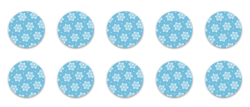Wrapped Coins Puzzle
 There are 10 standard coins lined up on a table, but each coin is wrapped up such that you can't see which side of the coin is facing up. All you are told is that exactly 8 of the coins have "heads" facing up.
There are 10 standard coins lined up on a table, but each coin is wrapped up such that you can't see which side of the coin is facing up. All you are told is that exactly 8 of the coins have "heads" facing up.
You must separate the coins into two piles such that each pile has the same number of heads facing up. You can turn the coins over, but you cannot see through the wrapping.
Is this possible? If so, how?
This section requires Javascript.
You are seeing this because something didn't load right. We suggest you, (a) try
refreshing the page, (b) enabling javascript if it is disabled on your browser and,
finally, (c)
loading the
non-javascript version of this page
. We're sorry about the hassle.
3 solutions
Please, could you explain the procedure in the last paragraph of your solution
Very nice solution and explanation, Eli.
but then shouldnt the first pile actually be equal to (8-x)-(8-x) because now then first pile contains a value equal to the number of heads it has subtracted from the number of heads the second pile has which has a value equal to that of its heads subtracted from the first piles heads, crearing a paradox and this you never know, or am I misunderstanding?
Log in to reply
You don't know what x is, but the question only requires you to know that each pile have the same number of heads, which we know is 8 − x , where x is the number of heads in the pile that you turn over before you turn it over.
Let me give an example. Let's say you take a group of 8 coins, and it just so happens that x = 7 of them were heads. (You don't know this.) This leaves 8 − x = 1 of the other two coins as being heads. When we turn over all 8 coins, the 7 heads become tails and the 1 tails becomes heads, leaving that pile with 8 − x = 1 coin as heads, just like the pile of two coins.
We are able to do this entire process without knowing what x actually is.
I am confused here. If my first split results in 2 heads in the pile of 2 and 8 tails in the pile of 8 - and I turn over all the coins in the 8 pile so all are now heads - how, exactly does 2 heads = 8 heads???????
Log in to reply
There are 8 original heads, so your pile of 8 would start with 8-2 = 6 heads.
Log in to reply
Suppose all eight heads come in the pile of 8,then what happens?
Log in to reply
@Sivaraj Rajagopal – you flip that pile of 8 heads. this will give you 0 heads in the eight coin pile, just like in the 2 coin pile.
@Sivaraj Rajagopal – 0 heads in both piles.. so same number of heads
Feel the coins and see if it feels like a head or not :')
The question just asked if it's possible. Logically, yes.
Solution: Take 8 of the coins into a "special pile". The special pile currently has some unknown number of heads, x , while the other pile of 2 coins must have 8 − x heads, since we know there are 8 heads in all. Turn over all 8 coins in your special pile, thus changing all heads to tails and tails to heads. Thus, the special pile now contains 8 − x heads, just like the other pile of 2 coins.
Further Exploration: In these kinds of puzzles, people often read a solution and think "wow, that does work, but how would I have thought of that...?". For this reason, I think it's valuable to discuss the thought process behind this solution.
At first, we might think about choosing some "special" group of coins (e.g., what if we take the 1st, 3rd, 5th, ...). However, since the coins are entirely indistinguishable from each other, there is no way to divide them into "special" groups that we could know anything about (unless we start turning some of the coins over).
Let's say we're going to take a pile of coins, and turn over some subset of that pile. How would we choose such a subset? There's no way to do this meaningfully, since all of the coins are still indistinguishable.
Thus, we're essentially left with only one meaningful action: take some pile of coins, and turn over every single one of them. How many should we take into this pile? Well, if the pile has P coins and x heads, the other pile has 8 − x heads. When we flip over all P coins, we will then have P − x heads. Setting P − x = 8 − x gives P = 8 .